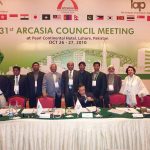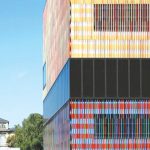-
The City Gallery
April 2011

Student: Anam Abdul Azeez
Town Hall Colombo 07
Institution: City School Of Architecture
Project: Part 1 Cdp-2010
It is a global dilemma that society is drifting apart. People are strung by virtual connections and face a loss of physical connectedness. Public buildings are an attempt to bridge this gap – to bring people together.
The Town Hall Triangle and its surrounds has lost its spirit over time due to disappearing social connectivity.
The City Gallery is an attempt to revive the spirits of people and rejuvenate this location.
THE SITE:
The Town Hall Triangle is rich in social, cultural and architectural value. This location includes:
Buildings of architectural importance. A distinct domescape. Buildings of social importance-catalysts-which draw users to the site. Buildings of religious importance, present on the triangle itself. The Park, and other Recreational Buildings. An important node in the transport network. A transition, from old to new, from quiet to loud. A myriad of users.
OBSERVATIONS MADE ON SITE:
The City and its people are somehow disconnected. At this node people are constantly in a rush and fail to observe each other and the rich history around them. The varied architectural character in this location is not appreciated – instead it seems to contribute to the chaos.
The Town Hall has lost its status as the Civic Centre of the City which was its initial purpose. The people itself are divided by social, ethnic and economic differences.
THE CONCEPT:
The City Gallery is an Interface which bridges the City and its People. It is a single, simple and elegant structure which breaks away from the chaos around it to provide relief to the people and establish a better connection between them and the City. Its simple elegance respects the ornament and character of its surrounding buildings.
The City Gallery is open to the Public irrelevant of their differences. It gives people an opportunity to unwind, appreciate art and technology, appreciate the City and connect with each other.
The Gallery’s skeletal structure is punctured by occasional solid volumes. The lightweight steel-frame structure contrasts the solid presence of historic buildings in the context.
The skin of the building shifts from being transparent to semi-transparent. This allows views of the Town Hall, Mosque and Post Office, and creates a flow of space and energy between the City, the Town Hall and the City Gallery.
The Gallery’s height terminates at a clean line which contrasts the domescape in the area, allowing it to take precedence.
The ground level of the Gallery is treated like a public plaza which extends into the Town Hall, restoring its status as a “Civic Centre’. This public space also unites the buildings on the Triangle itself allowing it to become a common whole.On a macro scale, the Town Hall Triangle is part of a developing ‘Recreational Zone’ which includes locations such as Sathutu Uyana, the Colombo Museum, the National Art Gallery, Lionel Wendt, and the upcoming Performing Arts Centre.
The City Gallery completes the area as the ‘Recreational Zone’ of the City and acts as a ‘Gateway’ into it through the Town Hall.
It provides information to users on other Recreational spots in the City creating a virtual network amongst these buildings which benefits the City as a whole.
The Ground Level is public and interactive, its porosity allows people to filter in from the two main roads, the node- via the Facility centre and the Town Hall itself.
Public circulation flanks the central atrium known as the ‘Link’. These circulation cores allow users to ascend into day-lit interior spaces of the two wings of the Gallery above which comprise of more contained functions, into which access maybe controlled. The two wings are linked by light-weight bridges and volume variation.
Volumes allow visual and spatial links between floor levels. They allow panels to be let down through the building and sculptures to be suspended.
The occasional solid blocks contain functions which require more controlled internal conditions, and services.
SOCIAL IMPLICATIONS:
A common place exclusive to the public results in a reinforced sense of ‘togetherness’ amongst society at large, dispensing differences amongst them.
A stronger belonging to the City; as the public is better educated about its history, architecture and everyday happenings.
An appreciation for the sentiment in its architecture creates memories in people.
A better relation with the Municipal Council.
An opportunity for the young and old to appreciate art together, which helps bridge the generation gap.
A prominent contemporary art gallery is an asset to the society of artists.
The public have an opportunity to be introduced to, understand and appreciate technology. A society that is less stressed and refreshed is more productive.
The creation of an ‘atmosphere’ at night much needed due to the lack of night activity in the area.
The creation of job opportunities within the building.
The revival of the Town Hall as a symbol of the City with the ‘City Gallery’ making a statement,
‘A building that relates the old and new but represents its own age with integrity’.
















